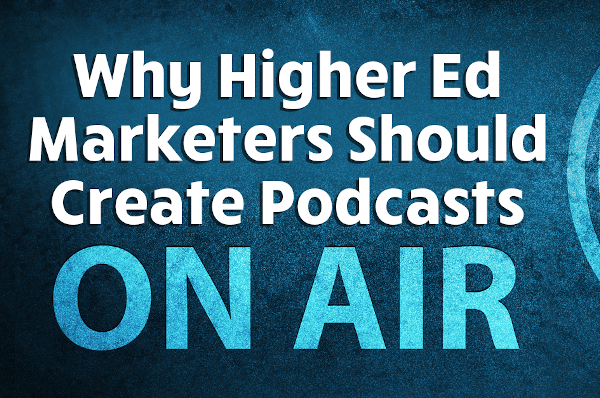
Stamats Insights
March 11, 2019

As an academic institution marketer, a top priority is reaching prospective students and their parents with the right message to attract more of the right students. These students will become the voices of your brand, amplifying their support, opinions and insights about the organization for years to come on their resumes, social media and potentially your planned giving registries.
The challenge of reaching these prospects, however, is perhaps more complicated than in any other industry – how do you reach digital natives who are bombarded daily with messaging and have grown up accustomed to tuning it out? How do you reach parents who already have preconceived notions of where their kids should go, based on their personal attachments to schools and the proximity of their offspring?
More and more, the answer has been podcasts. Podcasts are among the fastest-growing content marketing media today for the 18- to 34-year-old demographic. Check out these insights from Forbes and Edison research:
While popular, many colleges and universities struggle to launch and maintain podcasts. Marketers cite having difficulty with finding unique angles, producing engaging conversations and continually and effectively distributing segments. When that’s true, it’s important to partner with experts in interviewing and podcast production to ensure optimal outcomes.
Considering starting a podcast? Connect with us for a virtual strategy session.
What is a podcast?
A podcast is a recorded conversation about a trending or evergreen topic. The conversation can be two or more people talking to each other, or one engaging individual discussing a topic solo. The average podcast is about 45 minutes. Often, podcasts include ads up to 90 seconds, which are typically relevant to the topic or the host’s industry.
Aren’t podcasts a lot of work?
It’s a misconception that podcasts are a lot more work than other marketing endeavors. Really, many organizations create a podcast-worthy conversation before writing a blog article – they just don’t realize it.
When a writer sits down to interview a subject matter expert for a blog article, for example, they often discuss the topic in terms that are conversational for the intended audience. If the writer records the interview, they have essentially recorded a podcast. Pre-interview planning is important, of course, but the processes are similar.
Also, podcast production doesn’t have to be technically complex. In fact, over-production can make the conversation sound staged and sterile rather than conversational and engaging. Successful podcasters strike a balance between polished and natural audio.
How do we place a podcast on our website?
Some organizations use a separate hosting solution such as Libsyn, which offers podcast access through an audio player on your website. These solutions often offer distribution options to publish your content on multiple podcast platforms at once.
Other organizations embed podcast audio within their site as an audio file that visitors can use to download or listen live. Taking a cue from Netflix, many organizations implement a category listing by topic. This format is familiar to the on-demand generation, and it is user centric because it’s based on an individual’s interests.
Determining where to house your podcast is part of our discovery process. The key is to implement a system that allows you to easily feed your podcasts into networks such as iTunes and others, which is usually done through an RSS feed.
How do we distribute a podcast?
Podcasts can be distributed similarly to blog articles and videos. We typically recommend the Create Once, Publish Everywhere (COPE) model to syndicate podcast content:
Additionally, higher education organizations can sponsor podcasts that are produced by other organizations, such as publishers or agencies, to reach a potentially untapped segment of your target audience. Sponsorship might entail having one of your subject experts interviewed by the host, buying an ad in an organization’s podcast (if the topic is relevant to your market) or perhaps submitting your own podcast for distribution to an organization’s audience.
How do we know whether it’s working?
If you use Google Analytics or a similar system as part of your digital strategy, you can set up goals and events to track where listeners come from, how many listen live, how many download and (most importantly) what they do next or on subsequent visits to your site. Podcast networks have varying levels of available analytics as well.
We encourage clients to use these data to inform their content marketing and email nurturing campaigns. For example, if your listeners come in from social media, listen live and browse your site for application information, the user might be ready for a stronger conversion message than a user who listens, leaves your site and returns for your next podcast a week or two later.
Podcasts are commuter-friendly, on-demand and user-driven – the perfect media to deliver your relevant messaging to high school students, their parents and non-traditional students who are on the go. We expect podcast engagement to continue to grow in 2019 and beyond.
As you approach your podcast strategy, keep these most important guidelines in mind: your content must be relevant to your audience, and you must deliver it consistently across multiple media in order to generate return on investment. When done well and delivered with a smart, intuitive distribution process, podcasts support and enhance your brand’s positioning, values and business goals.
Ready to Get Started?
Reach out to us to talk about your strategy and goals.